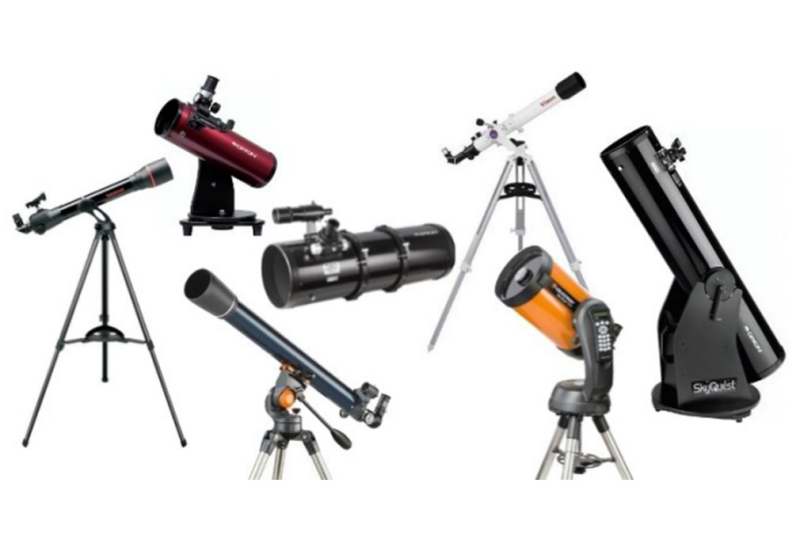Beginner's Guide
Telescopes - Page 2
Telescope Mounts
A telescope is almost worthless without a mount. Binoculars generally top out at 15X as it becomes nearly impossible to hold them steady enough and most telescopes have a magnification of 25X at the low end. But a telescope mount needs to do even better than that. They must hold objects rock steady even at high (200X up) magnification. So your mount really needs to be good. The mount can be light if the telescope is also, but as your telescope weight increases, so will the mount.
Alt/Azimuth Mounts
An Alt/Azimuth (aka Azimuth, Alt-Az) mount is very simple, allowing telescopes to be moved in altitude (up and down), or azimuth (side to side), as separate motions. A major advantage of this type of mount is the simplicity of its mechanical design. Also, per pound of weight it will support, it's the lightest mount. The reason is that all the big forces on its parts go straight down so gravity works in its favor.

- Simple - up/down, left/right horizontal movements
- Generally less expensive
- Generally less massive
- Does NOT follow objects as they move, unless computerized
- Generally not suited for photography
- Difficult to use when objects are almost directly overhead.
Equatorial Mounts
An equatorial mount is probably not very simple at first to any beginner. That is because the major advantage is it's designed to follow the motion of a celestial object in the sky with one motion. All of the mounts seen in the image that follows are the German equatorial type.
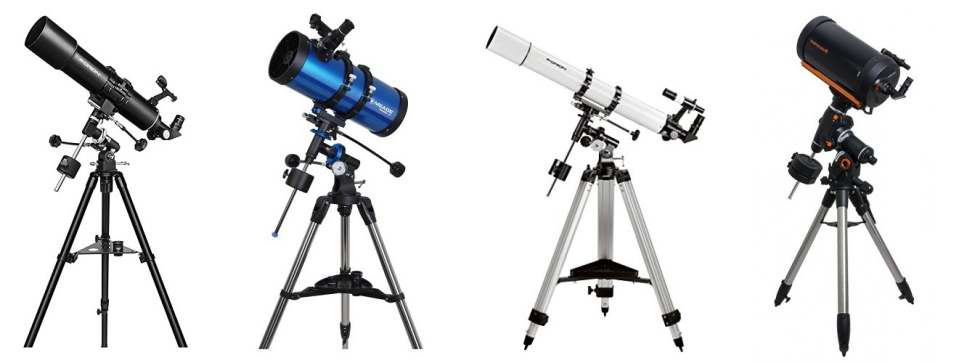
- Automatically follows objects as they move in the sky when a simple motor is added
- Take an Alt/Az mount and tilt it toward the North Celestial Pole and you have an equatorial
- German equatorials need counterweights
- Fork type equatorials do not need counterweights
- Good for astrophotography
- Difficult to use when pointing near the Celestial Pole
- Requires some polar alignment.
Computerized Mounts
Though they will cost a little more, you may want to consider a computerized mount. You can simply plug in the object you want, hit the goto button and the telescope will then slew to that position. But
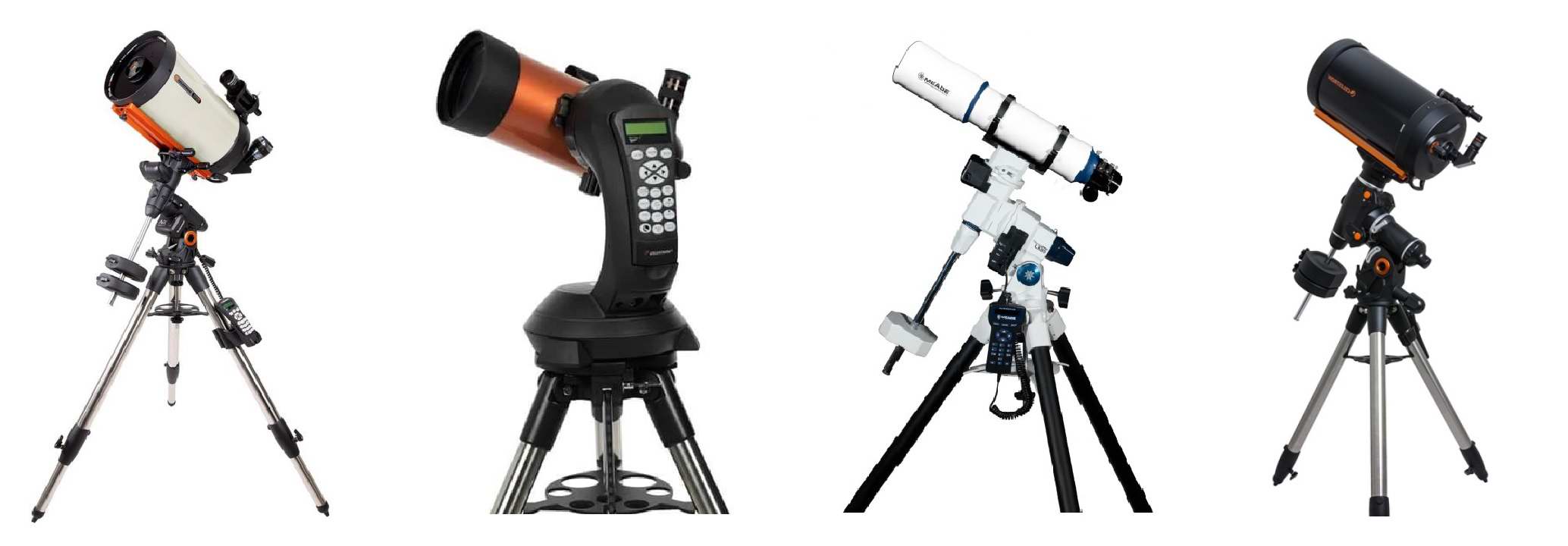
- Can be motorized (GOTO) or not (Push To).
- Spend more time observing, not hunting.
- Good for adults short on time or experience.
- Requires some polar alignment
- Requires some time at the beginning of an observing session synchronizing the mount.
Dobsonian Telescopes
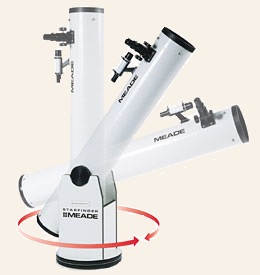 A Dobsonian telescope is an alt-azimuth mounted Newtonian telescope. It is called that because the design was popularized by John Dobson.
It is a marvel of simplicity and it has very good objective size to weight ratio and is credited with vastly increasing the size of telescopes
available to amateur astronomers.
A Dobsonian telescope is an alt-azimuth mounted Newtonian telescope. It is called that because the design was popularized by John Dobson.
It is a marvel of simplicity and it has very good objective size to weight ratio and is credited with vastly increasing the size of telescopes
available to amateur astronomers.
Dobsonian telescopes are almost exclusively used for visual observations. The big trade-off in the design is the use of the simple alt-azimuth mount.
Dobsonian Variations

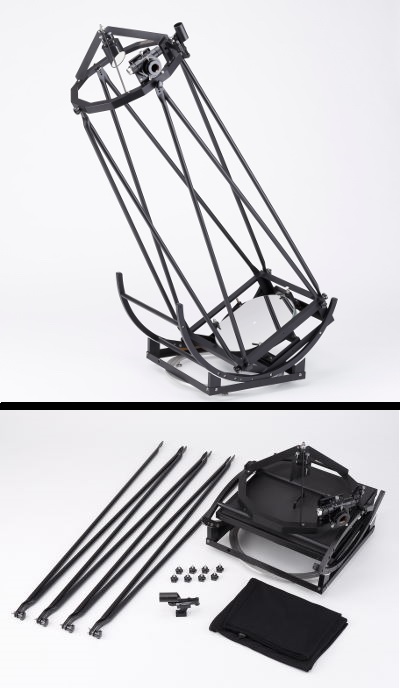
- Classic Solid Tube. This is by far the most common because it works well for Dobsonians 10" or less.
- Collapsible Tube. Better for slightly larger telescopes. This makes the scope lighter.
- Removable Truss Tube. This design not only removes weight, but it makes the scope more mobile.
- Ultralight / Ultracompact. This is taking the mount and tube size down to an extreme. A 12" Dobsonian with this design be just 30lbs!
- Push To or GoTo.
Finders
Every telescope should have some sort of finder scope. This is either a low power telescope or a so-called 1X pointing device because finding something directly in the main telescope is extremely difficult.
Optical Magnifying Finders

- These are small refractor telescopes. We recommend that the objective be 50mm because you can see fainter stars and the view of some larger objects is better in the finder than the main scope.
- Magnify from 5X to 10X so you can see a wide field of view, typically 5°
- Permanent eyepiece with a crosshair reticle.
- We don't recommend a finder that inverts the image as they are difficult to learn how to use.
Zero Power Reflex / Telrad

- Naked-eye view only
- No magnification; 1X
- The 2 units to the left in the diagram project a red dot
- The 3 units to the right are Telrads. It projects a bullseye target in the sky.
Focusers
A focuser is a standard item on any telescope. It has two functions: 1) it holds your eyepiece, and 2) it focuses that eyepiece. Focusers basically come in two sizes: 1¼" and 2". Eyepieces come in those two sizes. With an adapter you can place a 1¼" eyepiece in a 2" focuser, but the opposite you really can't.

- Rack & Pinion
- Simple, classic focuser. In the images above, the left one is a 1¼" model. The second from the left is a 2" model.
- Crayford
- Shown as the 3rd focuser above.
- Roller-bearing design provides zero image-shift through focusing range - significantly improves performance compared to rack and pinion focusers.
- Helical
- Shown as the rightmost focuser
- Rotate to focus
- Inexpensive
- Can provide good focus, but it requires excessive rotation. We don't recommend this focuser.
Binoculars
Binoculars should be in every astronomers tool kit. But as we stated earlier, we don't advocate that you must buy a set of binoculars before you buy a telescope. However, if you already don't have a decent pair, eventually you will. The reason is that binoculars generally have much lower power than a telescope. This means they have a much wider field of view. If you want to view the Milky Way, you're going to get a better view than a telescope. The same thing goes when a great comet makes an appearance.

Imprinted on almost all binoculars are two numbers that look like this: 8X50. The first number is the magnification, so in this example it's 8X. The second number is the diameter of the objective lens in millimeters, so in this case it's 50mm. 50mm is close to 2 inches. The larger this number, the greater the light gathering ability. For astronomy we think that 50mm is the minimum. Though there are models of binoculars that offer a zoom feature, most simply have a fixed magnification. How much magnification? For a 50mm lens 8-11X is pretty good. Why not higher? First, as is always the case with magnification that you get a smaller field of view as it increases. This is exactly the same with a telescope. But with binoculars there is another liability: ability to hand hold. By 15X if gets very difficult to hold binoculars and get a steady image and by 20X they really need to mounted on a tripod.
 Another number often imprinted is the field of view (FOV). They usually are given in degrees (as in the examples above), but you'll also see
it given like the photo on the left, in this case it says: 367FT at 1000YDS.
That means when looking through those binoculars, when you're looking at
something 1000 yards away, you can see something that is 367 feet wide
and/or tall. It's therefore a measure of the field of view and had they
given it in degrees, it would have been 7.0°.
Fortunately, most manufacturers are going away from this nomenclature and
using degrees instead.
Another number often imprinted is the field of view (FOV). They usually are given in degrees (as in the examples above), but you'll also see
it given like the photo on the left, in this case it says: 367FT at 1000YDS.
That means when looking through those binoculars, when you're looking at
something 1000 yards away, you can see something that is 367 feet wide
and/or tall. It's therefore a measure of the field of view and had they
given it in degrees, it would have been 7.0°.
Fortunately, most manufacturers are going away from this nomenclature and
using degrees instead.
 The magnification spec is not everything. Look at the two fields at the right. The magnification is identical, but as you can see the
one on the left has a larger FOV. This is because the "apparent" FOV (the size of the circle) depends on the eyepiece. Ones with larger FOVs
are generally more expensive because they have more lens elements and also need to be of higher quality.
The magnification spec is not everything. Look at the two fields at the right. The magnification is identical, but as you can see the
one on the left has a larger FOV. This is because the "apparent" FOV (the size of the circle) depends on the eyepiece. Ones with larger FOVs
are generally more expensive because they have more lens elements and also need to be of higher quality.
In pictures of the binocular examples we are showing two different types. The ones on the left use a Porro prism and there is a jog in the light path. These are the traditional binoculars. The ones at the right use a Roof prism and the design make it appear that the light path goes straight through, but that is really not true. They are a newer design.
Porro vs. Roof Prisms
- Porro Prism
- Pros
- Superior clarity
- Better depth perception (irrelevant for astronomical viewing)
- Wider FOV
- Overall better image quality
- Design allows for larger objectives
- Generally lower price for same objective size
- Cons
- Bulkier and heavier
- Less waterproofing quality
- Lower durability
- Pros
- Roof Prism
- Pros
- Better for very small (<35mm objectives) binoculars
- More compact and lighter
- Better durability
- Better waterproofing quality
- Cons
- Less Clarity
- Less depth perception (irrelevant for astronomical viewing)
- Narrower FOV
- Design doesn't allow for larger objectives. Max size about 56mm.
- Generally higher priced for same objective size
- Pros
Telescope Truths
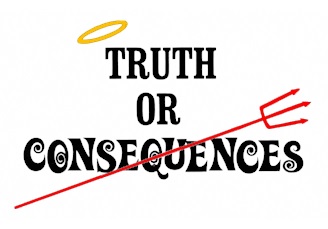 Here is some advice as it helps to know the truth.
Here is some advice as it helps to know the truth.
- More aperture is (usually) better! You can ...
- See dimmer objects
- See bright objects better
- See more details.
- The mount must be solid!!!
- If not the view will be jiggly and objects will not be seen as well as scope is capable of.
- If not it will be harder to find objects
- If not it will be generally frustrating
- You can spend as much or more for a mount as the scope
- Magnification is overrated
- Magnification is irrelevant when buying (!)
- Magnification is mostly limited by the atmosphere.
- Highest magnification: Up to 50x per inch under good conditions with good optics; smaller in larger scopes.
- e.g. 4":200x 6":300x 8":400x 10": 500x
- High powers used only for Moon, planets and close double stars.
- Any telescope gives "high" magnification with an eyepiece with a short enough focal length.
Putting It All Together
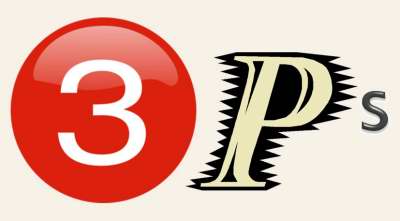 We call this the 3 p's.
We call this the 3 p's.
- Purpose
- What do you want to observe? No telescope shows all object types well.
- Portability
- Can you lift it? Can you transport it? Will you want to after carrying it 10x? In the cold with gloves?
- This conflicts with the need to have a good firm mount where heavier is better, so you probably have to strike a balance between weight and portability.
- Price
- After picking scopes based on the above, narrow down by price. Don't exclude your perfect scope based only on price.
- Don't sacrifice quality for aperture!
Questions To Consider When Buying a Telescope
 Questions as they apply to the 3 p's as discussed above.
Questions as they apply to the 3 p's as discussed above.
- 1st P: What do you want to look at? The moon, planets, bright nebula, double-stars, galaxies?
- 2nd P: Will it fit in your vehicle? Room for gear?
- 2nd P: How far will you need to move the telescope to setup and use it?
- 3rd P: How much do you want to spend?
Telescopes aimed at Beginners
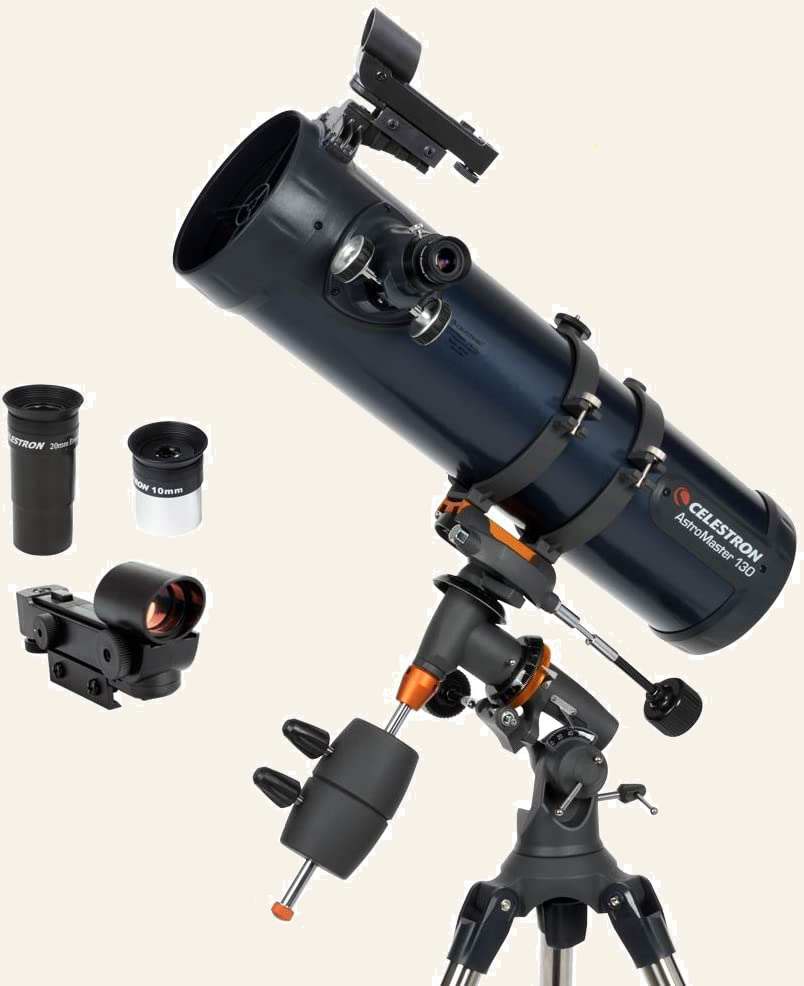 Many of the commercial telescope manufacturers have models geared toward beginners. But they almost never market them that way.
However, they are fairly easy to spot.
Many of the commercial telescope manufacturers have models geared toward beginners. But they almost never market them that way.
However, they are fairly easy to spot.
First, not surprising is that they are lower priced. A beginner is usually not willing to spend a lot of money on an instrument, specially when they're not certain they're going to enjoy astronomy. Second, they come with a variety of accessories. They will always come with some sort of finder scope (refractor or 1X). They also come with 2 eyepieces (one lower power and one higher). And occasionally they will come with a barlow.
The more advanced and especially more expensive telescopes are geared at the advance amateur with lots of experience. They are more picky about the accessories, especially the eyepieces. For example, if you think $300 is a lot of money for a beginner telescope that includes 2 eyepieces, you can spend more than that on just one eyepiece! Some will buy just the OPT (Optical Tube Assembly) because they are going to buy the mount separately.
But we are not trying to talk you out of a so-called beginner telescope. In fact this is what we recommend. It just has to meet the 3 P's criteria.
What Scope is Best for Given Objects
Note that we're saying Best and not Only!
| Obj \ Scope Type | <4" | <8" | >=8" | Short FL | Long FL | Lens | Mirror | Cat |
|---|---|---|---|---|---|---|---|---|
| Sun | X | X | X | |||||
| Moon | X | X | X | X | X | X | ||
| Planets | X | X | X | X | X | |||
| Star Clusters | X | X | X | X | X | X | X | |
| Nebulae | X | X | X | X | ||||
| Galaxies | X | X | X | X | ||||
| Double Stars | X | X | X | X | X | |||
| Comets | X | X | X | X |
A telescope is not needed for aurora or meteors.
"Long FL" (Long Focal Length) is anything greater than 900mm or 36 inches. "Short FL" is 900mm/36 inches or less.
And the winner is ...
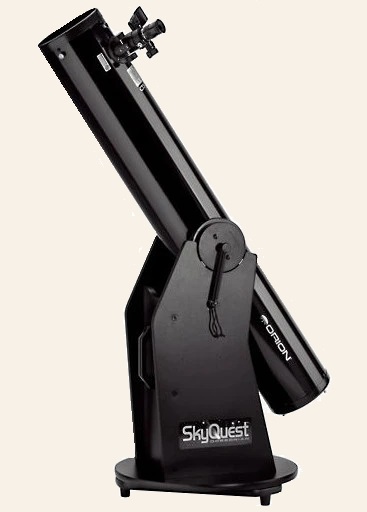
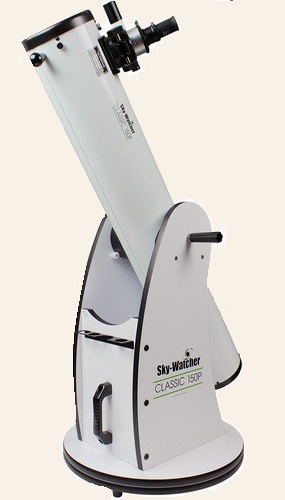 Though they might not always be the winner, a good choice for a first scope is a 6-inch f/8 Dobsonian mounted reflector. Think of the 3 P's
we presented.
Though they might not always be the winner, a good choice for a first scope is a 6-inch f/8 Dobsonian mounted reflector. Think of the 3 P's
we presented.
Portability: These scopes are very easy to move and transport. They don't weigh very much compared to other telescopes and mounts. The simplicity of the Dobsonian mount is the reason. They are very simple to set up.
Price: They are fairly reasonably priced for what you get.
But, again, this may not be the best choice for you. Choose the one that means your needs!
Further Reading
Sky and Telescopes - Hobby Killers: What Telescopes Not to Buy.

